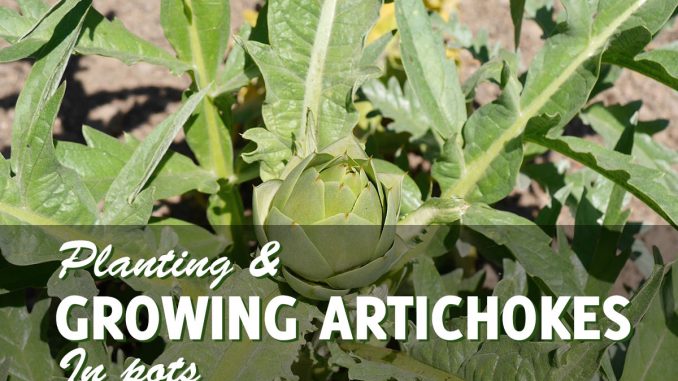
Artichokes are much loved by Italians (and everyone else) for their unique flavor and texture. You can either eat the hearts alone or pluck out the outer leaves to nibble at the tender core. It is a tender perennial plant that produces that edible thistle bud that can even grow to a spectacular flower to decorate your garden. As a normally wild-growing plant, you will need a very large container if you wish to start growing artichokes in pots.
Before You Start Growing Artichokes in Pots
Climate is very important when growing artichokes in pots. They prefer to have mild winters and enjoy a long summer that’s frost-free and not dry. There are several ways for you to start your cultivation. You can start growing your crops from seeds or root divisions. Choose a place where your artichokes will get the most amount of sun without the shade. Artichokes prefer an area that has at least or more than 100 frost-free growing days. It would grow best in places where night temperatures reach no more than 75°F during daytime no less than 50°F during the night.
Picking the Right Pot to Grow Artichoke In
Artichokes can grow to be as tall as 3 feet and as wide as 5 feet. You will need a large pot for just one plant alone if you are growing artichokes in pots. Your container should have a capacity of at least two cubic feet of soil. To make it easy, you need a pot that is at least 20 inches deep and 24-30 inches wide.
This Polyethylene Barrel Planter is about the smallest pot for artichokes you would want to try. Whatever container you choose you must ensure there is adequate drainage. This can be accomplished by drilling numerous drain holes at the bottom since artichokes are very susceptible to getting waterlogged. Line the bottom with fiberglass netting or small pieces of broken terracotta pots to prevent soil erosion and facilitate water drainage.
Preparing your soil or potting mix for artichokes
Choose a soil that is light and loamy so that it retains moisture while effectively draining excess water. A pH of 6.0-6.8 is preferred when growing artichokes in containers.
You can put in fertilizer with your soil mixture according to package instructions. For a less complicated and much safer option, incorporate compost or mature manure a few days before you plant your artichokes in pots.
Seeds
Seeds can be started indoors by sowing them directly in soil 2-3 weeks before the last spring frost. Give it a head start by soaking the seeds for 8 hours in water before placing them inside a container with damp soil. Cover and place the container inside your fridge for two weeks before you sow them. If you are having trouble finding artichoke seeds locally you can always purchase them online.
You will still need to consider the 2-3 week time frame before the last spring frost when you do this. Sow in 3 seeds about an inch into the soil about 4 inches apart. Germination starts within 7-10 days in temperatures 70°F -80°F. Thin the seedlings down to 1 once true leaves have formed.
Artichoke Root Divisions for Growing in Pots
Artichokes from root divisions are an easier way to start growing artichokes in pots. It is better and cheaper if you would have a neighbor that will be kind enough to give a division from a well-established plant.
You can only get a rooted shoot when the plant is no less and no more than 10 inches high. Any smaller will kill the plant, and any bigger will be quite hard to cut. Get your rooted shoot when the foliage has thinned or died, which is around autumn. Get to an off-shoot and cut a ring around the roots with the use of a spade.
It is best to get a rooted shoot from a local gardening store if you are not sure of how to cut one off. Dig a hole in your container, about 18 inches, and fill it with water. Soak the roots in this hole by placing it vertically. Cover your shoots by filing up the hole until just enough with the base of the shoots above soil level. Water the plant to help settle down the soil.
Caring for Your Container Asparagus
Artichokes require a lot of nutrients and water as they grow dense foliage and a lot of bulbs. This is particularly important when growing artichokes in pots, for there is not enough soil to maintain adequate moisture and nutrients. Use high-nitrogen liquid fertilizers that are water-soluble about three to four weeks. It is best to side-dress your plant with mature compost manure for this purpose as well as feeding your plant with compost tea every week or two.
Watering
Water your artichokes well three to four times a day. It is important that you keep your plant adequately hydrated to produce tender and succulent buds. Still, be careful not to overwater your plant as overwatering causes the crown to rot.
Weeding
Prevent weeds from overpowering your plant while growing artichokes in pots by hoeing on the soil or by straw mulching. Weeds are greedy and will steal water and nutrients from your artichokes. Pull them out as soon as you see them growing at the base of your plant. Mulching is also important to help retain moisture and to preserve warmth, especially when you are growing a perennial artichoke.
Harvesting the Artichokes You Grew in Pots
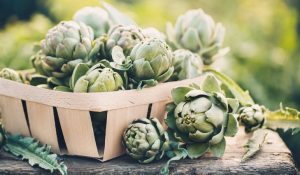 Harvest the buds when they are still tight and firm when growing artichokes in pots — harvest by cutting the bud about 1 ½ – 2 inches from the base. Afterward, the stem from where you harvested your bud will start o dry up. Promote further production by removing this dried up stem. The buds can be stored in the fridge for up to 1 week. They can also be frozen after being cooked or canned. Pickling artichokes can be a great way to preserve the hearts and be a perfect addition to salads.
Harvest the buds when they are still tight and firm when growing artichokes in pots — harvest by cutting the bud about 1 ½ – 2 inches from the base. Afterward, the stem from where you harvested your bud will start o dry up. Promote further production by removing this dried up stem. The buds can be stored in the fridge for up to 1 week. They can also be frozen after being cooked or canned. Pickling artichokes can be a great way to preserve the hearts and be a perfect addition to salads.
Looking for more vegetables to try in your containers? Check out our article on growing corn in pots!

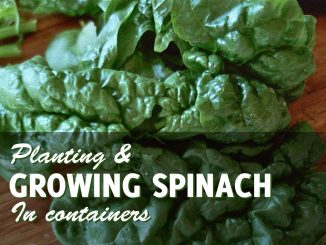
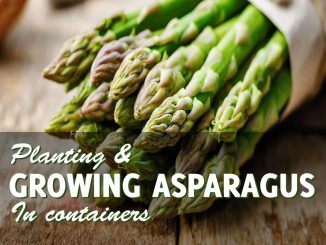
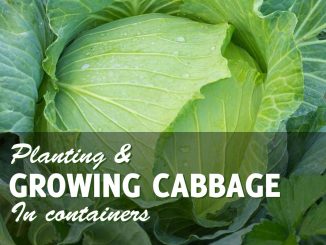
Be the first to comment